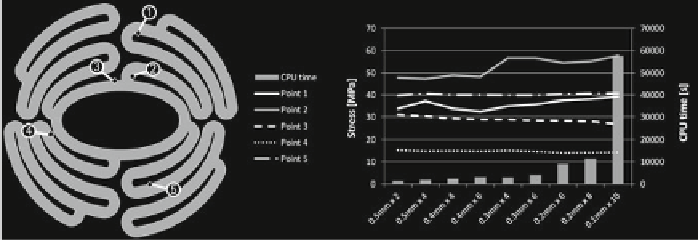Biomedical Engineering Reference
In-Depth Information
Ta b l e 2
True stress and true plastic strain data of Mg-alloy LA63 [
25
]
True stress (MPa)
137
150
174
187
197
True plastic strain
0.0000
0.0020
0.0107
0.0182
0.0263
2.1.4 Parameters
The magnesium alloy LA63 is not commercially available. Its properties were deter-
mined through tensile testing, and found to be: Young's modulus of 46,068MPa and
Poission's ratio of 0.28. Nonlinear material parameters are given in Table
2
; isotropic
hardening was assumed. Myocardium and sutures as well as thumbs were assumed
to be linearly elastic and isotropic, Young's moduli were chosen as 66MPa [
27
] and
1,300MPa, for the myocardium and sutures (thumbs), respectively.
Surface-to-surface contact was defined between interacting bodies, and friction-
less contact was assumed. The penalty method was used as contact algorithm with a
stiffness scale factor of 0.01.
Components were meshed with linear hexahedral elements with incompatible
modes (C3D8I). A sensitivity analysis was performed to choose an appropriate mesh
size. Accordingly, the model of the preformed scaffold was meshed with different
refinements. Von Mises stresses were determined at five points and compared to the
element sizes as shown in Fig.
4
. Further, the computing time was contrasted. Stress
changes were observed at points 1 and 2, while all other locations were unaffected.
These two points are in or close to tight radii where higher stress concentrations can
be assumed; therefore a higher sensitivity to the mesh size is observed. An element
size of '0
6' was chosen in order to adequately account for sharp corners and
complex geometries while still maintaining a reasonable computing time. Therefore,
a 1mm thick scaffold was meshed with an element edge size of 0.2mm and six
elements in thickness.
.
2mm
×
Fig. 4
Sensitivity study on mesh refinements and resultant stress in five points














